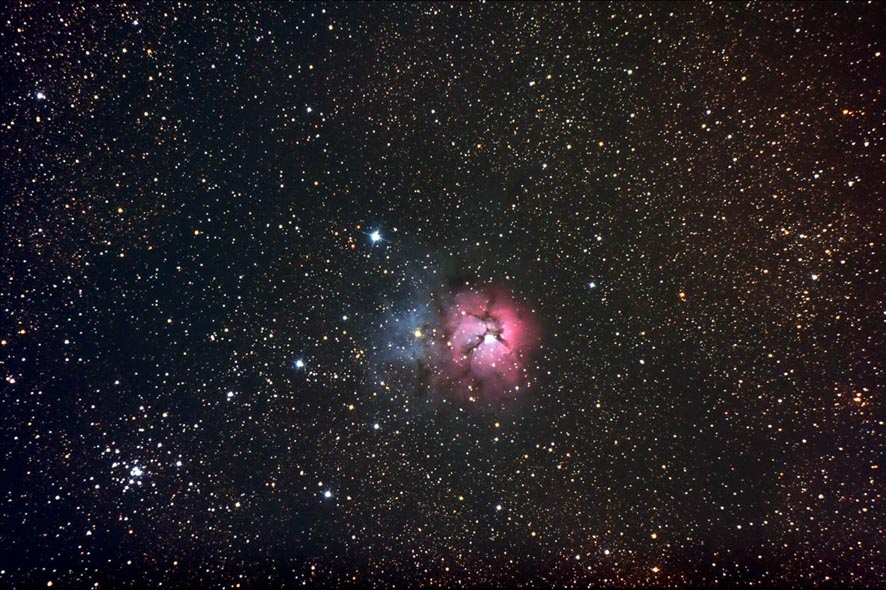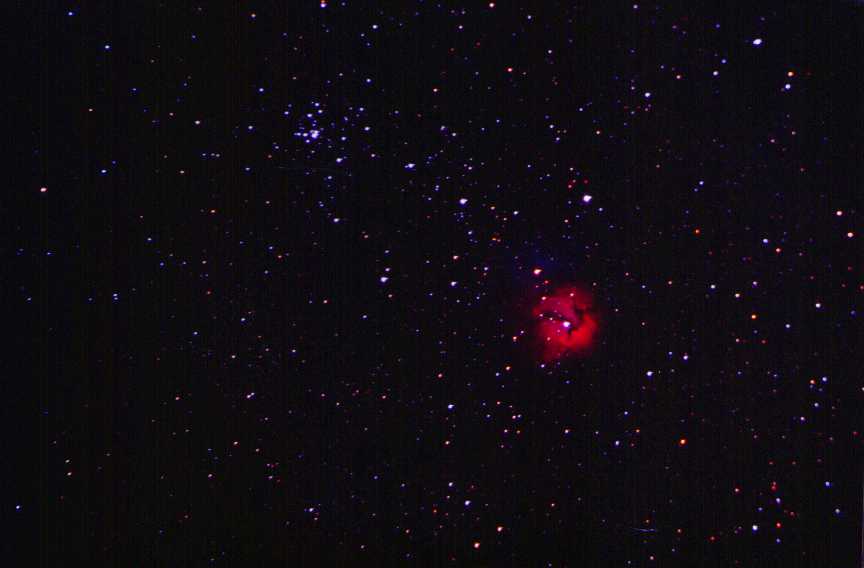 |
18/08/2007 | Immagine di Alessandro DI GIUSTO |
Ripresa dal Monte Matajur (Ud) |
Sezione Deep Sky |
 | ||||
| NEBULOSA TRIFIDA M 20 / NGC 6514 (TRIFID NEBULA) | ||||
| Descrizione Dreyer: VB,VL,TRIFID,D*INV | ||||
| Ascensione retta: 18h 02.3m; declinazione: -23░ 02' | ||||
| Dimensioni: raggio 29.0'; magnitudine: 6.3 | ||||
| Separazione da M 21: 00░ 45' 07" | ||||
| AMMASSO APERTO M 21 / NGC 6531 | ||||
| Descrizione Dreyer: CL,PRI,LC,ST9...12 | ||||
| Ascensione retta: 18h 04m 36.4s; declinazione: -22░ 29' 56" (J2000.0) | ||||
| Dimensioni: 13.0'; magnitudine: 5.9 | ||||
Nella nuova immagine qui presentata si osservano la famosa nebulosa Trifida M 20 e il vicino ammasso aperto M 21, situati in cielo nella
costellazione del Sagittario (Sagittarius-SGR). L'ammasso aperto M 21 / NGC 6531 Ŕ un oggetto meno conosciuto, rispetto ad altri ammassi aperti come le Pleiadi, le Iadi, il Presepae o h e Chi Persei, ma resta sempre un soggetto interessante, ricco di giovani stelle azzurre. Si osserva in basso a sinistra, abbastanza disperso ma con parecchie stelle osservabili nell'immagine. 
Ecco i dati forniti dal planetario Guide 8.0: Commenti tratti dal Progetto NGC-IC: Resti di una nebulosa galattica o di una supernova Tipo: EN+OCL Asc. retta: 18 02 42.0 (J2000) Declinazione: -22 58 19 Magnitudine: 6.3 Asse maggiore: 28.00 minuti d'arco Costellazione: SGR Designazioni alternative: M 20 OCL 23 ESO 521-N*13 LBN 27, Trifid n Asc. retta: 18h02m42.0s Declinazione: -22 58' 19" Note dal Catalogo NGC2000: J2000 AR: 18h02.3m J2000 dec: -23 02' !!! vB, vL, trifid, D* inv; = M20 NGC 6514: a magnificent or otherwise interesting object very bright, very large, trifid, double star involved; = M20 Commenti dalle Osservazioni di Steve Coe: NGC 6514 (M20) Very bright, very large, irregularly round, approximately 40 stars involved in a nebula that is criss-crossed by dark lanes at 135X. The Trifid is naked eye from even a moderately dark site. The UHC filter enhanced the nebulosity, but I like the view of this object better without the filter. The triple star in the center of the brightest section is HN 40, it is split at 165X and it two yellow and one light blue star embedded within the Trifid nebulosity. Ultimate Star Party, McDonald Obs. Oct. 95, S=6, T=8, 24" f/5-- Trifid in 24" f/5 is gorgeous, the 27mm and UHC filter bring out both the upper and lower nebulosity, I cannot see color in them, but the two parts of the nebulae ¨have a different appearance, maybe "sheen". That is obvious once I noticed it. The HN 20 double star is easily split, with 23 other stars within the nebula. Camp 613 S=8 T=10 A WOW night for the Trifid 13 inch Naked eye a small, but easy glow "above" the Lagoon 11X80 easy to see, pretty large fuzzy spot and the brightest 4 stars involved are seen. 100x--very bright, very large, irregular shape, like a figure 8, 38 stars invovled, a very faint outer shell of nebulosity extends East and West from the main Trifid shape. The dark lanes which give it that name are obvious, they extend out into the very faint outer nebulosity. 100X + UHC WOW!! Just like a picture, the filter gets rid of the faintest stars involved, but provides a spectacular view of the nebula. Dark crooked lanes cut the nebula to pieces and divide the north blue and south red section. 220X--HN 40 is actually a triple star at this power, there is a 12th mag. comes to the north of the bright pair. At this power the nebula fills the field of view and the dark lanes cut through that glow with much fine detail. The cental star of the northern blue section is light orange. The UHC does not help at this power, better at higher powers without the filter. Commenti tratti dal SAC (Saguaro Astronomy Club) 7.2: NGC 6514 M 20 Tipo di oggetto: CL+NB Costellazione: SGR Asc. retta: 18 02.7 (J2000) Declinazione: -22 58 Dimensioni: 28.0 Classificazione: E+* 67 stelle La stella pi¨ brillante Ŕ di magnitudine 6 vB,vL,Trifid,D* inv Trifid nebula;sev dark lanes;H IV 41 & V 10;D* HN 40 invl  Quest'immagine ha una dimensione di 864 x 568 pixel ed Ŕ a 16,8 milioni di colori; occupa 2.8 MB, qui compressi a 20 KB. | ||||
| Telescopio per inseguimento: Vixen Rs200 | ||||
| Digicam: Canon EOS 350D | ||||
| SensibilitÓ equivalente: 400 ISO | ||||
| Tempo d'esposizione: somma di 10 pose da 10 minuti |  |
20/07/1998 22? T.U. |
Immagine di Paolo BELTRAME |
Ripresa dal Monte Matajur (Ud) |
Sezione Deep Sky |
 | ||||
In precedenza nel nostro sito internet era presente l'immagine presa dal socio Paolo Beltrame. Potete vederla appena qui sopra e vi invito
a confrontarla con la ripresa fotografica digitale di Alessandro Di Giusto a inizio pagina, di modo che possiate apprezzare quale notevole
incremento di prestazioni permettano le ultime digicam nella ripresa delle nebulose a emissione (la parte azzurrina della Trifida). La nebulosa
in emissione, la parte rossa della Trifida Ŕ sempre ben evidente, ma nella ripresa di inizio pagina i colori sono molto pi¨ "morbidi" e naturali,
mentre nelle riprese fotografiche del decennio passato si doveva riprenderle per molto tempo e pure elaborarle per mostrare anche solamente questa parte.
Il risultato anche delle stelle che compongono l'ammasso aperto Ŕ completamente diverso, essendo ben impressionate e dai colori molto pi¨ naturali
rispetto alla ripresa su pellicola chimica di Beltrame. Per visionare altre immagini della nebulosa Trifida, cliccate qui.  Quest'immagine ha una dimensione di 864 x 568 pixel ed Ŕ a 16,8 milioni di colori; occupa 2.8 MB, qui compressi a 20 KB. | ||||
| Telescopio Newton: Marcon 200 mm; F=1000 (F/5) | ||||
| Diapositiva: Kodak PJM-2 | ||||
| Tempo d'esposizione: 12 m | ||||
Ammassi Aperti |
Nebulose |
Fotografia, ccd e ricerca |
Articoli
| ||||
